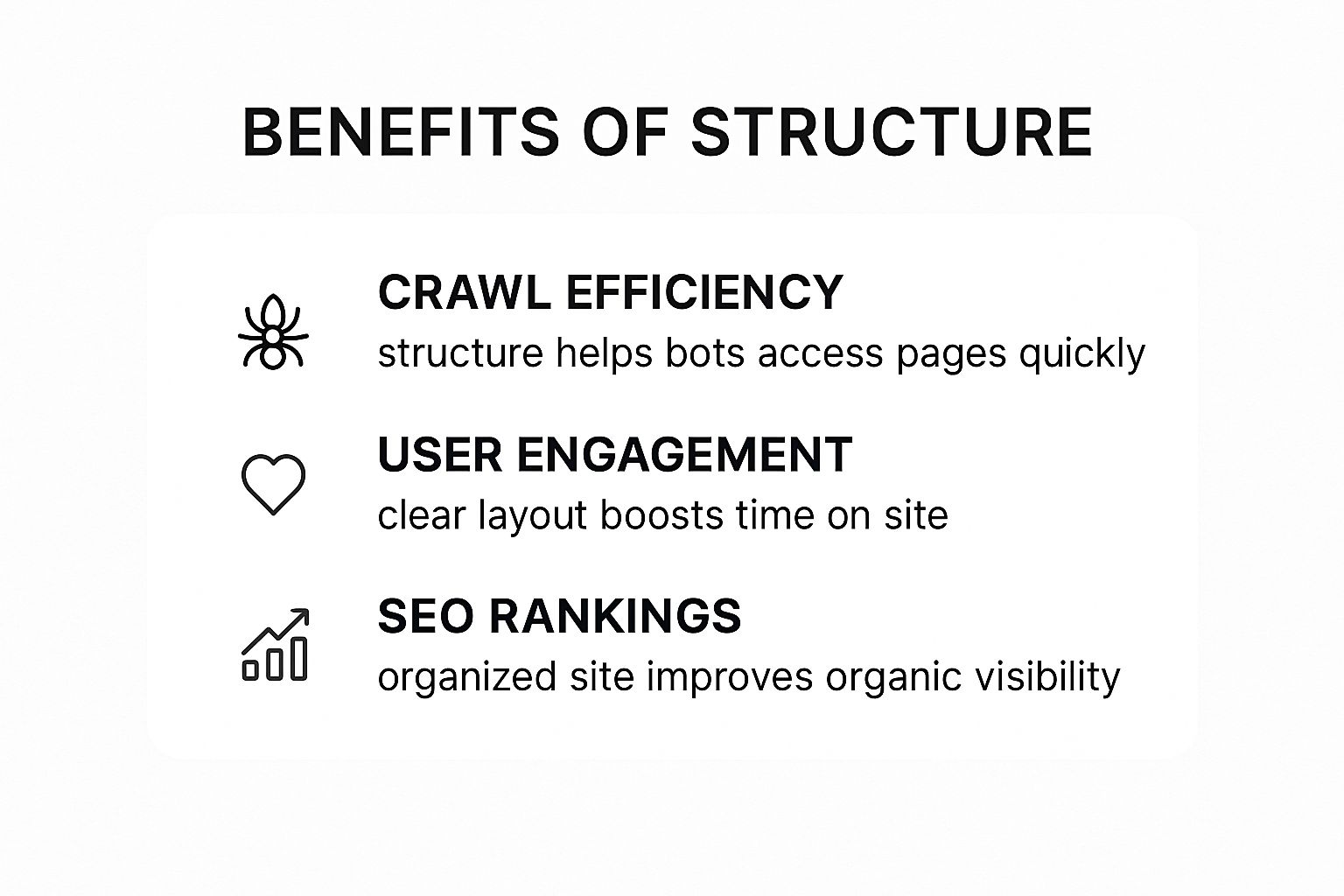The Business Impact of Site Structure SEO

A well-defined site structure is essential for online success. It's not just a technical aspect; it's the foundation upon which your entire online presence is built. It directly impacts how search engines like Google interpret and rank your content, and how easily users can navigate your site. This, in turn, affects crucial business metrics. A poorly designed structure can lead to high bounce rates, with frustrated visitors leaving quickly. In contrast, a clear and intuitive structure encourages users to explore, increasing time-on-site and driving conversions.
How Site Structure Affects Key Metrics
A logical site structure creates a positive user experience. This translates to tangible business benefits. When visitors can easily find what they need, they're more likely to become customers. Investing in site structure SEO is about optimizing the entire customer journey. This results in lower bounce rates, increased time spent on your site, and higher conversion rates, all of which positively impact your bottom line.
- Improved Conversion Rates: A well-structured site simplifies the process of finding products or services, leading to more sales and leads.
- Reduced Bounce Rates: Users are less likely to leave your site immediately when they can quickly access relevant information.
- Increased Time-on-Site: An easily navigable website encourages visitors to explore more content, increasing their engagement with your platform.
Search Engines and User Experience
User experience is crucial, and search engines also rely heavily on site structure. A well-organized site makes it easier for search engine crawlers to discover and index your content. This improved crawlability ensures that your valuable pages appear in search results. A clear hierarchy helps search engines understand the relationships between your pages, assigning appropriate value and relevance. Current technical SEO statistics emphasize the importance of site structure. Over 23% of websites don't utilize structured data, missing out on enhanced search features. Structured data helps search engines interpret and display content effectively. As of 2025, 87.7% of websites use HTTPS, a strong indicator of the trend toward secure, well-structured sites. For more insights into these trends, see these statistics on technical SEO: Learn more about technical SEO stats.
The Competitive Advantage of a Strong Site Structure
In the competitive online world, a robust site structure is a key differentiator. A well-optimized website attracts more organic traffic and builds topical authority. Organizing content into logical clusters demonstrates expertise to search engines. This leads to higher rankings for relevant keywords, driving targeted traffic and reinforcing your position as an industry leader. A well-structured site also builds user trust. A positive user experience fosters a perception of credibility and trustworthiness, which leads to increased engagement, return visits, and stronger customer loyalty.
Crafting a Site Structure That Search Engines Love
A visually appealing and easily navigable website is essential for a positive user experience. But to truly maximize your site’s performance, you need a structure optimized for search engines. This goes beyond simply using keywords. It's about designing an architecture appreciated by both users and search engine crawlers. This involves carefully considering how your pages are organized and interconnected, which directly impacts your site structure SEO.
Page Hierarchy and Ranking Potential
A well-defined page hierarchy acts as a roadmap for your website. It dictates which pages are most important and how users and search engines should navigate to them. Visualize it as a pyramid: your homepage at the top, followed by main category pages, then sub-category pages, and finally, individual product or content pages. This structure ensures efficient flow of link equity (the value passed between pages) from top to bottom, boosting the authority of key pages. This helps search engines understand your site’s focus and prioritize content accordingly.
For example, an e-commerce website selling clothing might use a hierarchy like this: Homepage > Men's Clothing > Shirts > T-Shirts. This clear structure improves both user navigation and search engine understanding.
The Importance of Logical URLs
Your URLs are more than just web addresses; they signal the content of your pages to search engines. Clear, descriptive URLs with relevant keywords help search engines quickly understand each page’s topic, improving your search ranking potential. Avoid long, complicated URLs with excessive numbers and symbols, which can confuse both users and search engines. Understanding site structure SEO is crucial for business growth; to delve deeper, learn how to improve search engine ranking.
Content Clusters and Topical Authority
Organizing your content into content clusters is a powerful strategy for building topical authority. This involves creating a central "pillar" page on a broad topic and linking it to related "cluster" pages covering specific subtopics. This interconnected structure demonstrates in-depth knowledge of a subject area to search engines, boosting your ranking for related keywords.
For instance, a pillar page on "site structure SEO" could link to cluster pages on topics like "URL optimization," "internal linking," and "mobile site structure." This approach strengthens your site’s overall authority on the core topic.

The infographic above illustrates the benefits of a well-structured website: improved crawl efficiency for search engine bots, enhanced user engagement from a clear layout, and better SEO rankings. A well-structured site benefits both users and search engines, creating a positive feedback loop where improved user experience and SEO performance reinforce each other. For a deeper look at our site architecture, you can explore our sitemap.
To understand the impact of various structural elements, let's analyze their individual contributions to SEO, user experience, and implementation difficulty.
The table below, "Site Structure Elements and Their SEO Impact," compares these different elements, highlighting their relative importance for online success.
| Structural Element | SEO Impact | User Experience Impact | Implementation Difficulty |
|---|---|---|---|
| Clear Page Hierarchy | High - Improves site organization and link equity flow | High - Makes navigation intuitive | Medium |
| Logical URLs | Medium - Helps search engines understand page content | High - Improves user understanding and shareability | Low |
| Content Clusters | High - Establishes topical authority and improves keyword ranking | High - Provides comprehensive information to users | Medium |
| Internal Linking | High - Distributes link equity and guides users | High - Enhances navigation and content discovery | Medium |
| Mobile-Friendly Structure | High - Improves mobile ranking and user experience | High - Essential for mobile users | Medium |
As the table demonstrates, each element plays a vital role in achieving both strong SEO performance and positive user experience. While some elements are easier to implement than others, the benefits they provide make the effort worthwhile. By focusing on these structural elements, you can create a website that is both loved by search engines and appreciated by your users.
Internal Linking Strategies That Actually Work
The foundation of effective site structure SEO lies in strategic internal linking. However, many websites miss the mark. Visualize your website as a city: internal links are the roads connecting different pages (neighborhoods). Without well-planned roads, navigation becomes a challenge, isolating some areas and causing congestion in others. Similarly, a website lacking a strategic internal linking structure becomes confusing for users and search engine crawlers, negatively impacting performance and visibility in search results.
Identifying High-Value Linking Opportunities
Effective internal linking isn't random; it's about creating a logical flow of information. Begin by identifying your most important pages—key product pages, core service offerings, or top-performing blog posts. These are your central hubs. Link to these hubs from relevant supporting content to distribute link equity. This boosts their authority and signals their importance to search engines. For example, a blog post about keyword research should link to your keyword research tool product page. This connection is logical for both users and search engines.
Optimizing Anchor Text for Maximum Impact
Anchor text, the clickable text of your links, is crucial. Use descriptive anchor text that clearly indicates the linked page's content. Avoid generic options like "click here" which offer little context. Instead, use keywords relevant to the linked page. However, avoid over-optimization by stuffing keywords into every anchor text, which can lead to penalties. Aim for a natural and varied anchor text profile.
The Hub-and-Spoke Model for Content Ecosystems
The hub-and-spoke model is a highly effective internal linking strategy. Choose a core topic (your hub) and create a comprehensive page about it. Then, create separate pages (spokes) focusing on specific aspects of that topic. Link each spoke back to the hub and, where relevant, to other spokes. This creates a tightly knit content cluster, establishing topical authority and enhancing navigation. This structure is particularly beneficial for blog content. Read also: How to master your site architecture.
Addressing Orphaned Content
Orphaned content refers to pages without internal links. These pages are isolated and difficult to find. Internal linking and page hierarchy are fundamental to site structure SEO. Research indicates that 59.5% of websites lack an H1 tag, crucial for search engine understanding and user navigation. Furthermore, 51.3% of websites have more than one H1 tag, which can confuse search engines. Find more detailed statistics here.

Identify orphaned content through site audits and integrate them into your internal linking strategy by linking from relevant pages. This improves crawlability and maximizes content value. To further enhance your understanding of site structure’s role in SEO, consider reading about SEO for Ecommerce Website. Implementing these strategies creates a well-connected website benefiting both users and search engines, driving organic traffic and improving overall site performance.
Leveraging Structured Data for Competitive Advantage
While foundational SEO practices remain essential, structured data offers a significant opportunity to enhance your website's visibility and gain a competitive edge. This involves implementing schema markup, which provides search engines with a comprehensive understanding of your content. Think of it as giving search engines a detailed blueprint of your website, clarifying the context and meaning of each element. This improved understanding allows search engines to present your content more effectively in relevant search results.
Understanding the Benefits of Schema
Schema markup enhances how search engines interpret your content, leading to richer, more informative search results. This includes features like rich snippets, which provide additional information directly within the search results, and knowledge panels, which offer a summarized overview of your business or topic. These enhancements make your listings more prominent and engaging, increasing click-through rates from search engine results pages (SERPs). For example, recipe schema can display ratings, cooking times, and images directly in search results, capturing user attention and providing immediate value.
Choosing the Right Schema for Your Business
Various schema types cater to different business needs and content formats. Local businesses can leverage schema to prominently display their address, phone number, and operating hours. E-commerce websites utilize product schema to showcase pricing, availability, and customer reviews directly in search results. For publishers, article schema highlights authorship, publication dates, and other relevant information. Selecting the appropriate schema type ensures that search engines accurately understand your content and present it in the most relevant search context.
Practical Implementation of JSON-LD
JSON-LD is the recommended format for structured data implementation. It's a JavaScript-based notation embedded within your website's HTML. This method is generally preferred for its ease of implementation and minimal impact on website performance. JSON-LD also keeps structured data separate from website content, simplifying management and updates. Various tools and generators are available to assist with JSON-LD creation and implementation, ensuring proper formatting and reducing errors.

Adding structured data strengthens site structure SEO, a critical factor for competitive rankings. Common formats already in use include Open Graph (67.7%), Twitter Cards (52.4%), and JSON-LD (49.7%). Each format influences how site information appears in search results and on different platforms. Implementing structured data is vital for improved indexing, higher click-through rates, and more accurate SERP displays. This is particularly important given that Google now rewrites up to 76% of titles in search results, emphasizing the importance of robust site structure and metadata. Explore this topic further.
Validating and Maintaining Structured Data
After implementing schema markup, validation is essential. Tools like Google's Rich Results Test help confirm correct formatting and identify any errors. Regular checks and updates ensure your structured data remains aligned with your content and avoids potential issues. Consider structured data as an ongoing process, not a one-time task. As your website content evolves, so should your structured data. Consistent maintenance ensures accuracy and maximizes its positive impact on search visibility.
Mobile-First Structure for Core Web Vitals Success
Your site's architecture has a profound impact on Core Web Vitals, especially on mobile. These metrics, which focus on user experience, now directly influence search rankings. How you organize your mobile content affects not only usability, but also your search result visibility. Let's explore this essential link between mobile site structure and performance.
Balancing Information Architecture with Mobile Speed
Mobile users expect fast-loading websites. This requires balancing comprehensive information with optimal speed. High-performing mobile sites prioritize content based on user needs. Essential information is readily accessible, while less critical content can be placed in easily accessible menus or loaded progressively. For example, detailed product specifications could reside on a separate page linked from the main product page, reducing clutter.
Implementing Progressive Loading for Mobile Clarity
Progressive loading is crucial for mobile clarity and speed. It loads the most important content first, allowing quick interaction. Less crucial elements, like images or videos further down, load afterward. This maintains visual hierarchy and prevents slow-loading frustration, positively impacting site structure SEO by improving engagement and reducing bounce rates.
Mobile Navigation and Site Hierarchy
Mobile navigation should mirror your site's hierarchy but avoid clutter. Hamburger menus or tabbed navigation maintain structure within a compact interface. This allows easy access to all site sections without overwhelming users. Use descriptive menu labels for effective guidance. For more on SEO, check out our key SEO terms.
Optimizing for Different Mobile Website Types
Different websites need different mobile optimization strategies. E-commerce sites benefit from prominent search bars and filtered navigation for quick product discovery. News sites prioritize breaking news, while blogs focus on easy access to recent articles and categories. This targeted approach improves user experience and site performance.
Measuring the Impact on Core Web Vitals
Monitor Core Web Vitals after structural changes. Google's PageSpeed Insights provides valuable performance data. This data-driven approach allows for adjustments and optimizes mobile performance. Tracking metrics like Largest Contentful Paint (LCP) and First Input Delay (FID) reveals the impact of structural decisions.
Avoiding Desktop-Centric Pitfalls
Desktop-friendly decisions can hinder mobile performance. Large desktop images can slow mobile loading. Complex desktop navigation can become cumbersome. Design with a mobile-first mindset, prioritizing the mobile user experience.
To illustrate best practices for various website types, consider the following table:
Mobile Site Structure Best Practices by Industry
| Industry/Website Type | Recommended Structure | Navigation Pattern | Key Considerations |
|---|---|---|---|
| E-commerce | Product-centric, clear categories | Filtered navigation, prominent search bar | Fast loading times, easy product discovery |
| News | Prioritize breaking news, chronological order | Tabbed navigation, clear sections | Up-to-date content, easy sharing |
| Blog | Recent articles, clear categories | Hamburger menu, search function | Readability, easy navigation |
This table summarizes mobile site structure best practices by industry. Adapting your strategy to your audience and website type creates a positive mobile experience for both users and search engines.
Diagnosing and Fixing Site Structure Problems
Even well-designed websites can develop structural issues over time. Regular check-ups and maintenance are vital for a healthy site structure and strong SEO performance. This section provides a systematic approach to identifying and resolving common site architecture problems before they negatively impact your rankings.
Common Site Structure Issues and Their Impact
Several structural problems can hinder both user experience and search engine crawlability. Excessive crawl depth, for example, makes it difficult for search engines to access deeper pages. This can lead to important content being overlooked and not indexed, effectively hiding it from search results.
Keyword cannibalization, where multiple pages target the same keywords, confuses search engines about which page should rank. This dilutes your ranking potential. Navigation bottlenecks, where convoluted menus and unclear internal linking make it difficult for users (and search engine crawlers) to navigate, can significantly impact bounce rates, time-on-site, and conversions.
Auditing Your Site Structure With Free and Premium Tools
Diagnosing these problems requires a thorough site audit. Free tools like Google Search Console provide valuable insights into crawl errors, indexing issues, and mobile usability. Premium tools like That's Rank! offer more advanced features.
Deeper crawl analysis, internal link visualizations, and competitor benchmarking are just some examples. That's Rank! lets you quickly identify keyword cannibalization and pinpoint areas where your internal linking needs improvement, optimizing your site structure SEO.
Prioritizing Fixes Based on Potential Impact
Site structure problems should be addressed strategically, prioritizing fixes based on potential impact. Fixing broken links and addressing excessive crawl depth often provides quicker wins and a more immediate positive effect on search engine visibility.
More complex issues like reorganizing large sections or resolving extensive keyword cannibalization may require a phased approach. Start with the most important pages or sections to maximize impact.
Implementing Structural Improvements and Managing Redirects
Implementing structural improvements can seem daunting, but careful planning minimizes disruption. When restructuring URLs, implementing 301 redirects is crucial. This ensures users and search engines are seamlessly directed to the correct pages, preserving search rankings.
Clear communication with your development team is essential for a smooth transition and minimizes potential technical issues. The absence of a clear heading structure can impact ranking signals and user experience. Moreover, 80.4% of websites lack alt attributes for images, harming SEO and accessibility. Find more detailed statistics here.
Monitoring the Impact of Your Changes
Ongoing monitoring is vital after implementing structural changes. Tracking key metrics like crawl errors, indexed pages, and organic traffic reveals the effectiveness of your efforts. Regular site audits and performance reviews help identify and address unforeseen issues.
By continually analyzing and adapting, you can maintain a strong online presence and consistently improve your site structure SEO strategy and search engine rankings.
Future-Proofing Your Site Structure Strategy
As search algorithms evolve, your website's structure needs to adapt. Maintaining core SEO principles while embracing change is essential for long-term success online. This means anticipating how emerging trends will influence site architecture requirements and preparing your website to thrive in the ever-changing online world.
The Rise of AI-Driven Search and Content Relationships
Artificial intelligence (AI) is changing how search engines understand and interpret content. This shift emphasizes the importance of clear content relationships. AI algorithms can better identify related content when a site has a logical structure and strong internal linking. This reinforces the value of organizing content into topical clusters and using semantic HTML to enhance content connections. A well-structured site allows AI to grasp the connections between your pages, ultimately improving visibility.
For example, imagine a website about healthy eating. AI can easily connect a blog post about "meal prepping" to a recipe page for "healthy lunches" if the site structure and internal linking highlight the relationship between those topics.
Entity-Based Optimization and Structural Signals
Entity-based optimization focuses on building content around entities (people, places, things, concepts) rather than just keywords. This requires providing search engines with clear structural signals to understand these entities and their relationships. Structured data becomes critical for defining entities and creating a clear hierarchy. This helps search engines place your content within a broader knowledge graph, boosting understanding and ranking potential.
Voice Search and Navigation Expectations
The rise of voice search presents new challenges for site structure. Voice search queries are often longer and more conversational than text-based searches. This means anticipating how users phrase questions and structuring content to match those queries. Implementing clear navigation and descriptive anchor text improves the user experience for voice searchers and helps search engines deliver the most relevant results.
Building a Flexible Taxonomy
As your website grows, its taxonomy (how content is categorized and organized) needs to be flexible. Build a taxonomy that allows for easy expansion. Avoid rigid structures that may hinder future content additions. A hierarchical structure that naturally accommodates growth is key for long-term success.
Semantic HTML For Stronger Content Connections
Semantic HTML uses HTML elements to clearly define the purpose and structure of content. For example, using <article> tags for blog posts, <aside> for sidebars, and <nav> for navigation sections strengthens the semantic connections between your pages. This provides search engines with greater clarity about your content, which improves discoverability.
Designing Scalable Architectures
From the outset, consider scalability. A scalable architecture handles growth without causing structural problems. A well-planned hierarchy, a logical URL structure, and robust internal linking prevent bottlenecks and maintain site efficiency as more content is added. This forward-thinking approach ensures your website can easily expand as needed.
Implementation Roadmaps and Balancing Innovation
Balancing innovation with established best practices is crucial. While embracing emerging trends is important, don't neglect core site structure SEO principles. A solid foundation ensures a stable platform for experimentation and future growth. Websites at different stages of development may require different implementation roadmaps. A new website should prioritize establishing a clear hierarchy and URL structure. More established sites can focus on refining internal linking, implementing structured data, and optimizing for voice search.
Ready to take your site structure SEO to the next level and future-proof your website? That's Rank! provides the tools and insights you need to analyze your current structure, identify areas for improvement, and implement a winning strategy. Start optimizing your website today!